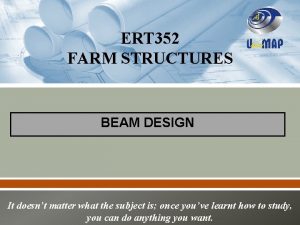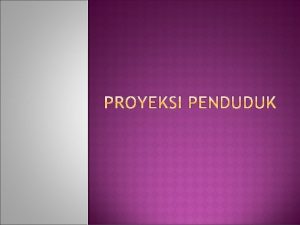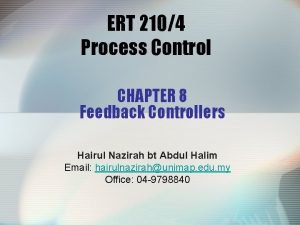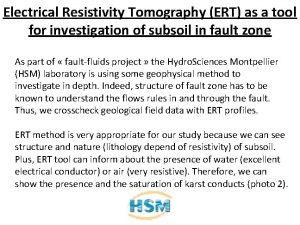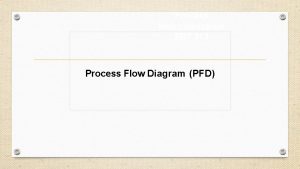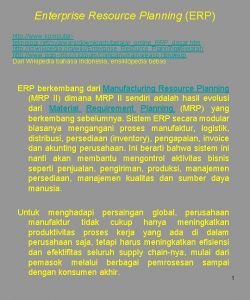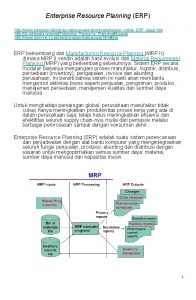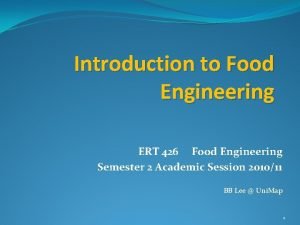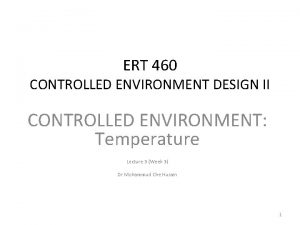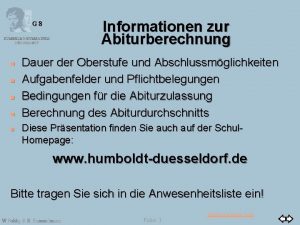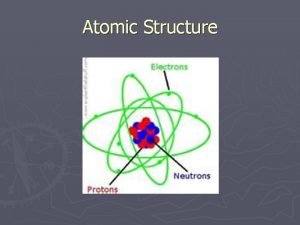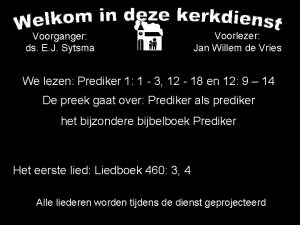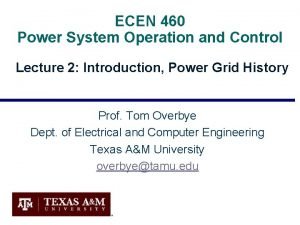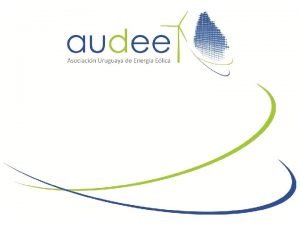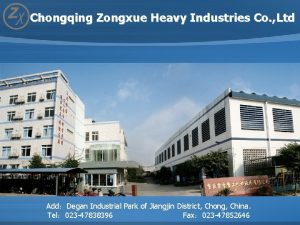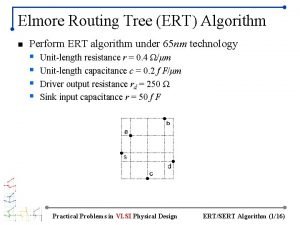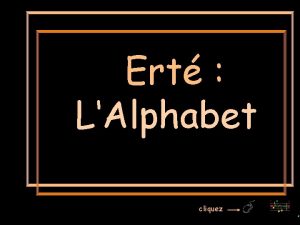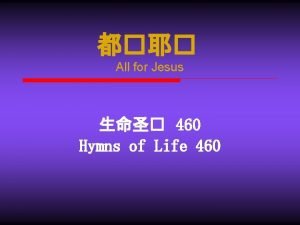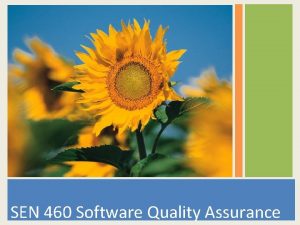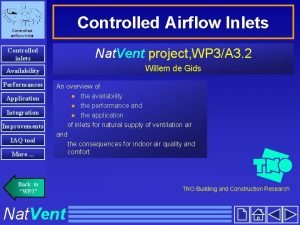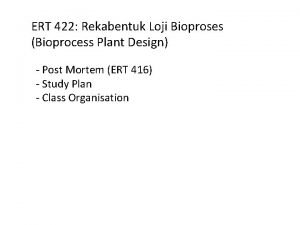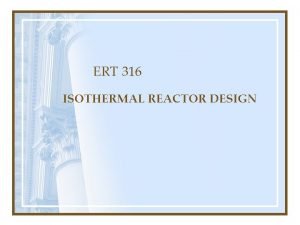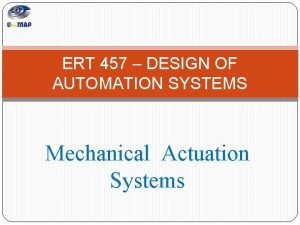ERT 460 CONTROLLED ENVIRONMENT DESIGN II CONTROLLED ENVIRONMENT






















- Slides: 22

ERT 460 CONTROLLED ENVIRONMENT DESIGN II CONTROLLED ENVIRONMENT: Temperature Lecture 3 (Week 3) Dr Mohammud Che Husain 1

Controlled Environment: Temperature The temperature in plant, animal and aquaculture structures from sensible heat balance for steady state heat transfer.

1. 0: Temperature in plant/animal/ aquaculture structures Environment parameters to be consider: – Temperature – Light intensity & Solar radiation – RH – Wind speed – Gases (CO 2 & NH 3)

• Temperature: major factor negatively influence all livestock/aquaculture/crops production. This will affect: – Food/nutrient intake – Metabolism (conversion of nutrients into products) such as: – Meat, Milk & Egg – Heat dissipation (alter the partition of energy) Heat that causes a change in temp of an object is called SENSIBLE HEAT. 4

Greenhouse for crop

Animals Barns need good in-house environment (temp, RH, light, O 2)

Aquaculture Building

2. 0: Sensible heat • heat exchanged by a body that changes the temp. & some macroscopic variables of the body, but leaves unchanged certain other macroscopic variables ( volume/pressure). • When an object is heated, its temp. rises as heat is added. The increase in heat is called sensible heat. • Similarly, when heat is removed from an object & its temp. falls, the heat removed is also called sensible heat.

2. 1: Sensible energy balance (SEB) • example of SEB is shown below: The energy flow term are: qs = SH gain from animals qm = SH gain from mechanical sources (motor/lighting) qso = SH gain from sun (thro window/glass panel) qh = SH gain from heating system qvi = SH gain thro ventilation air coming into house qw = SH loss thro wall/ceiling/window/door qf = SH loss thro floor qe = SH loss to latent heat (water evaporation from floor/leaves) qvo = SH loss thro in ventilation air leaving the house

2. 2: Steady state SEB Gains – Losses = change of storage (if conditions are steady-state, there is no change in storage) • Steady-state SEB is rearranged in the form: Gain = Loss qs + qm + qso + qh + qvi = qw + qf + qe + qvo

Energy balance can be used for the determination of: – heating & cooling – ventilation rate – indoor air temperature – insulation requirement • Hence, the component of energy balance must be quantified.

2. 2. 1: Sensible heat produced by animal, qs • Animal must live within “Comfort zone” & must prevent from ‘Thermal stress zone’ • Animals lose heat to surrounding by radiative , convection transfer and also conductive heat transfer (body to floor). • Sensible heat lost primarily from the outer surface of animals • Latent heat lost from respiratory tracts.

Albright, L. D. (1990). Environment control for animals and plants. ASAE Textbook

Example 1: Determine the sensible heat production from 100 dairy cow each at 590 kg wt housed in a barn at 12 o. C. Solution: refer to Appendix 5 -1: • At 10 o. C 500 kg cow lost SHP = 1. 5 W/kg • At 15 o. C 500 kg cow lost SHP = 1. 2 W/kg • Interpolating linearly for 12 o. C, (qs )500 kg = 1. 2 + (2/5)(1. 5 -1. 2) = 1. 32 W/kg • 590 kg cow lose heat >500 kg cow by the ratio: (590/500)0. 734 (qs )590 kg = 1. 32 W/kg (500) (590/500)0. 734 = 745 W/cow • If 100 cow, total sensible heat : 745 W/cow X 100 cow = 74. 5 k. W

2. 2. 2: Sensible heat from mechanical source, qm • Lighting is the largest source heat • Source from Motor are assume negligible unless if it operate continuously

Example 2: A poultry building is lighted by fluorescent lights generated 40 w/m 2 of floor area. The barn is 12 m wide by 40 m long. Estimate the sensible heat generated from this source. Solution: Floor area = 12 m X 40 m = 480 m 2 Total lighting capacity = 480 m 2 X 40 w/m 2 = 19, 200 w = 19. 2 kw Assume additional 20% heat generated by ballast use: 1. 2 X 19. 2 Kw = 23 k. W

2. 3: Sensible Heat Balance (SHB) qs + qm + qso + qh + qvi = qw + qf + qe + qvo Can be rewritten into : qs + qm + qso + qh = ∑UA (ti-to) + FP (ti-to) +1006ρV(ti-to) + qe Where: ∑UA = sum of heat loss conduction (from wall/ceiling/window) ti = Air temp. inside to = Air temp. outside FP = perimeter heat loss conductance, W/k ρ = air density, kg/m 3 V = ventilation rate Animal House: • i) qs & qe are combined into 1 = q s • ii) transmitted solar input to barn is usually neglected • iii) heat from mechanical sources is assumed negligible • • • Supplemental heat in barn is not frequently used. When this simplifying assumption are accepted, the energy balance reduces to: qs = (∑UA + FP +1006ρV)(ti-to) Ventilation rate, V = {qs - (∑UA + FP)(ti-to)}/((1006ρ)(ti-to))

Example 3 Determine the ventilation rate (m 3/s) required to maintain a dairy barn at 15 oc, given following condition: • No of cow = 60 , Av. wt = 580 kg • Wall area = 274 m 2, R-value = 2. 05 m 2 K/W • Ceiling area = 520 m 2, R-value = 1. 97 m 2 K/W • Window area = 12 m 2, R-value = 0. 30 m 2 K/W • Door area = 15 m 2, R-value = 0. 49 m 2 K/W • Perimeter length = 110 m, heat loss factor = 1. 5 W/m K • to = -5 o. C • Assume no heat from light & motor, little solar heating

Solution: • Data from Appendix 5 -1 will be use to calculate total sensible animal heat production: • (qs )580 kg = 1. 2 W/kg (500) (580/500)0. 734 X (60 cows) = 40, 000 W • Air density , ρ = 1. 14 kg/m 3 • FP = (110 m) x (1. 5 W/m K) = 165 W/k • Heat loss conductance from wall/ceiling/window/door: ∑ UA = ∑ (Ai/Ri) = 468 W/k V = {qs - (∑UA + FP)(ti-to)}/(1006ρ)(ti-to)) = {40, 000 w – (468 W/k +165 W/k) (20 K)}/(1006)(1. 14 kg/m 3)(20 k) = 1. 2 m 3/s

Assignment 1 1) Calculate the sensible, latent and total heat production from a flock of 30, 000 white leghorn laying hens with average weight of 1. 9 kg/bird keep in house at 24 o. C. 2) A poultry house used to raise 10, 000 broilers is operating in INSAT, Sungai Chuchoh. The latent and sensible heat of broilers is 6 W/kg. The growth rate is estimated at 0. 058 kg/day. Calculate the latent and sensible heat produced by the broilers at day 40. 3) A poultry building is lighted by fluorescent lights generated 40 w/m 2 of floor area. The building has floor area of 1200 m 2. Estimate the sensible heat generated from this source.

4) Determine the ventilation rate (m 3/s) required to maintain a barn at 18 o. C, given following condition: • No of cow = 1000 , Av. wt = 500 kg • Wall area = 274 m 2, R-value = 2. 5 m 2 K/W • Ceiling area = 520 m 2, R-value = 1. 7 m 2 K/W • Window area = 12 m 2, R-value = 0. 35 m 2 K/W • Door area = 15 m 2, R-value = 0. 59 m 2 K/W • Perimeter length = 120 m, heat loss factor = 1. 7 W/m K • to = -10 o. C

REFERENCESS • Albright, L. D. (1990). Environment control for animals and plants. ASAE Textbook.
 Ert uniform design
Ert uniform design Pt
Pt Ert controller
Ert controller Ert tool
Ert tool Ert diagram
Ert diagram Ert erp definition
Ert erp definition Ert erp definition
Ert erp definition Ert 1 programa
Ert 1 programa Ert products malaysia
Ert products malaysia Controlled environment design
Controlled environment design Atomic model diagram democritus
Atomic model diagram democritus Khrihfa hlabu 323
Khrihfa hlabu 323 460 punkte abitur
460 punkte abitur Ferrari rental houston
Ferrari rental houston Cis460
Cis460 460 democritus atom model
460 democritus atom model Liedboek 460
Liedboek 460 Who discovered roentgenograms
Who discovered roentgenograms 300'e yuvarlanan en büyük sayı
300'e yuvarlanan en büyük sayı Ecen 460
Ecen 460 Sen 460
Sen 460 Multis complex shd 460
Multis complex shd 460 St460ts
St460ts
